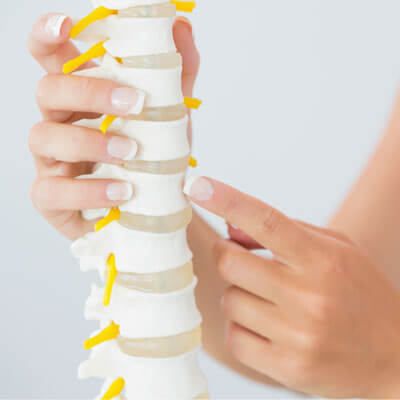
The spine is made up of 33 individual bones stacked one upon another. Between them the important spinal nerves pass supplying the body with nerve function. To allow mobility and make room for the spinal nerves the vertebral bodies are separated by spinal discs. They are cleverly designed to resist force, resist slipping and still allow a good range of motion around the segment.
Injury to the discs can occur and because of the complex nature of the structures that make up this area of the spine, symptoms can present very differently.
What does C1 supply?
C1,2 – Is the scientific abbreviation for the top two vertebra in the neck. These 2 ‘Cervical’ vertebra have nerves that supply some very important parts of the body. These include the Eyes, Ears, Scalp (Headaches), Pituitary Gland, Heart and Mouth. It is a very common part of the body to have problems. When stressed, people often report increased muscle tension in the upper cervical spine and shoulders. Over time this tension can manifest as headaches, neck stiffness, arm pain and is commonly believed to relate to degenerative change.
What does C7 supply?
C7 is the anatomical abbreviation for the lowest vertebra in the neck. Together with the T1 nerves some very important parts of the body are controlled through this part of the spine.
These include the heart, throat, oesophagus, shoulders, arms, hands and fingers. It is a very common part of the body to have problems, especially if you spend a lot of the time sitting. As with C1, stressed people often report increased muscle tension in the upper cervical spine and shoulders.
What does T4 supply?
T4 is the anatomical abbreviation for the fourth vertebra in the upper back. The nerves branching from this area supply the Heart, Oesophagus, Liver, Upper Arm, Gallbladder and Chest.
The parts of your body supplied by T4 are very important for full health. Ensuring that there is no interference to the nerve supply is part of an important strategy for optimal performance.
Sitting and stress are the main causes of problems here.
What does T10 supply?
T10 is the anatomical abbreviation for a vertebra in the mid-back. Injuries to this area are varied but usually have a rotation component. This area of the spine supplies nerves and control for the intestines, large and small, the pancreas, the spleen, the stomach, legs, appendix and reproductive organs. These are important parts of the body for digestion, hormone control, general movement and control of blood chemistry.
What does L1-3 Supply?
L1-3 is the anatomical abbreviation for a vertebra in the upper part of the lower back.
This area of the spine supplies nerves and control for the large intestines, abdomen, reproductive organs, prostate, bladder, appendix and certain parts of the legs & feet. These are important parts of the body for digestion, reproduction, hormone control, general movement and elimination of waste from the body. This area is damaged by twisting in people who have a largely sitting based lifestyle. This includes office workers and ‘weekend warriors’ who try things that they are not used to doing.
What does L4-S1 Supply?
L4-S1 is the anatomical abbreviation for a vertebra in the lower back. This area of the spine supplies nerves and control for the Prostate, Leg & Foot, Buttock, Muscles of Lower Back, Bladder and Anus.These are important parts of the body for digestion, reproduction, hormone control, general movement and elimination of waste from the body. This area is damaged by twisting in people who have a largely sitting based lifestyle.
Chiropractic care was studied for safety and was found to be one of the safest types of healthcare intervention. Very few clients reported side effects and many reported positive health changes other than those for which they had presented.
Do you know someone who should be seeing us? Forward this article or encourage them to call.
